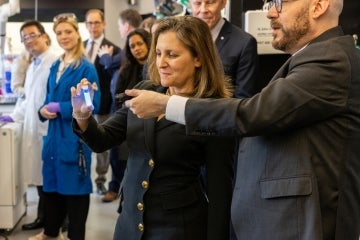
This is your brain on art: a Q & A with Oshin Vartanian
Published: July 18, 2014
As neuroscientists delve deeper into the mysteries of the human mind one area of study that continues to receive greater attention is the brain’s relationship to art.
The University of Toronto Scarborough's Oshin Vartanian is an expert on the neuroscience of aesthetics and creativity. In a recent study he explored the different ways people observe and appreciate art on a neurological level.
He spoke with writer Don Campbell about the major findings and how viewing art can stimulate areas of the brain in fascinating ways.
How did you go about studying the brains of people while they appreciate art?
There are many studies where people are placed inside MRI scanners and asked to evaluate paintings based on beauty or to judge the art based on how much they like it. Not surprisingly you get readings that show the brain is being actively engaged while looking at a piece of art. What we did is go through the literature and find 15 studies that had people looking at art for different reasons.
What did you find?
 We found that certain areas of the brain being engaged are easy to understand. These include areas involved in visual representation and object recognition such as the recognition of faces, processing scenes and locations and the ability to make certain movements or use certain objects.
We found that certain areas of the brain being engaged are easy to understand. These include areas involved in visual representation and object recognition such as the recognition of faces, processing scenes and locations and the ability to make certain movements or use certain objects.
The coolest thing we found is that areas of the brain involved in processing emotion and those that activate our pleasure and reward systems are also being engaged. We also found that the brain’s default mode network – the area associated with internally-oriented thinking like daydreaming, thinking about the future or retrieving memories – is also activated.
So what’s happening is that areas associated with more contemplative responses are being triggered automatically when people view art even if they don’t have instructions to judge or think about it critically.
It seems that people are hardwired to appreciate art?
Yes, that’s one way of looking at it. You have to remember that with an MRI scanner the technology is such that you can’t present images over a long period of time. You get a relatively quick snap shot and most of the studies only show paintings for no longer than six seconds. When people think about deep contemplation you get this image of someone at the gallery viewing a painting for a long period of time before they truly appreciate it and get a deeper sense of how they relate to the art. Again, if we look at the default mode network of the brain that’s being activated immediately, it also plays an important role in inner contemplation.
So I’m at the AGO and I become immediately entranced by a Monet hanging on the wall. I take it there’s a very good neurological reason why aside from it being very colourful?
 Well when it comes to art appreciation the areas of the brain that are most reliably engaged have to do with the instinctive experience of emotion or some pleasure-reward control system. As mentioned it also involves the brain’s default mode network, which essentially means people are processing it on a deeper level. So you have this parallel situation where you are deriving a very instinctive, pleasure and reward-oriented emotion and a more cognitive, contemplative response all at once. It can make for a powerful experience.
Well when it comes to art appreciation the areas of the brain that are most reliably engaged have to do with the instinctive experience of emotion or some pleasure-reward control system. As mentioned it also involves the brain’s default mode network, which essentially means people are processing it on a deeper level. So you have this parallel situation where you are deriving a very instinctive, pleasure and reward-oriented emotion and a more cognitive, contemplative response all at once. It can make for a powerful experience.
What about people who are professionally trained to evaluate art. Is there something unique about how they’re appreciating art compared to non-professionals?
There are definitely differences in preference. For example, those with no training or experience in art prefer representational art over abstract art, while those with a degree of experience show the reverse and prefer more abstract art. I think that the behavioural differences between the two groups are so apparent that there would have to be neurological differences as well.
Also, there are many studies that look at what factors explain the pleasure people get from viewing art. The data suggest there isn’t one important factor but a series of them. One factor is deriving an understanding or meaning from art. This is especially the case with abstract art because it’s so conceptual. I think when you have some context by which to understand the art there’s a higher likelihood you will enjoy it. Another factor is personality. People who score higher on the openness to experience dimension tend to appreciate art more.
Some people describe having a very visceral response to art, that it’s an immediate, full body experience. Is there anything in the research to suggest why this happens?
It’s interesting you should use the word visceral. One area that is actively engaged while viewing art is the interior insula, which historically has been associated with experiencing pain. Many early studies of the brain found that this area would be activated when viewing paintings and even sculpture, which didn’t make immediate sense because we tend to associate viewing artworks with some form of pleasure.
However, what a lot of recent studies have found is that this area is also responsible for experiencing pleasant emotions, especially ones that have a visceral aspect to them. Another area that’s engaged when viewing art is the putamen. This area is part of the basal ganglia, an important system in the brain for the experience of reward, among other things.
It seems the appreciation of art is the ultimate expression of a human brain that’s highly evolved?
I think that’s an intuitive way of looking at it. When the first studies came out ten years ago – and you have to remember this was very naïve neuroscience we’re talking about – people thought there may be a unique module in the brain connected to art. It all goes back to art being thought of as a real high order function of the brain. But in the last ten years the story has changed.
We know there are more cognitive and emotional areas of the brain being activated when people look at art but they are all bits and pieces that are meaningful in an evolutionary context. For example, there are areas of the brain known for processing faces, scenes, spaces, visual areas and those for processing memories that are all being engaged when viewing art. Humans are so successful because our brains have evolved these traits over time. If we put together all of the building blocks you literally have this well-oiled machine that’s set-up to enjoy and appreciate art in a variety of ways.


